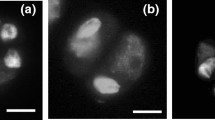Abstract
Karyomorphological studies were carried on three species of Haworthia Duval (family: Xanthorrhoeaceae) namely H. radula (Haw.) Duval, H. glauca Bak.var. herrei and H. limifolia Marl.var. keithii. Karyotyping through Image Analyzing System in three species of Haworthia (family: Xanthorrhoeaceae) reflected karyotypic orthoselection with same basic chromosome number (x = 7) and bimodal karyotype. In H. radula (2n = 14) two satellites were found one in each on the long arm of the two long chromosomes. H. glauca var. herrei and H. limifolia var. keithii possessed 2n = 28 somatic chromosomes. In addition pollen mitosis of each species was done. Pollens are endowed with expected number of n = 7 and bimodal chromosomes. Therefore karyotyping through Image Analyzing System suggests that H. radula is diploid (2n = 14) whereas H. glauca var. herrei and H. limifolia var. keithii are autotetraploid (2n = 28) plants.



Similar content being viewed by others
References
Bayer MB. Natural variation and species delimitation in Haworthia Duval. 3. Haworthia reinwardtii Haw. and Haworthia coarctata Haw. Nat Cact Succ J. 1973;28:80–6.
Bennet MD, Leitch IJ. Nuclear DNA amount and genome size in angiosperms. Ann Bot. 1998;82(Supplement A):101–5.
Brandham PE. Chromosome behaviour in the Aloineae. I. The nature and significance of E-type bridges. Chromosoma. 1969;27:201–15.
Brandham PE. Chromosome behaviour in the Aloineae. II. The frequency of interchange heterozygosity. Chromosoma. 1969;27:216–25.
Brandham PE. The chromosomes of the Liliaceae. II. Polyploidy and karyotype variation in the Aloineae. Kew Bull. 1971;25:381–99.
Brandham PE. Evolution in a stable chromosome system. Kew Chromosom Conf. 1983;2:251–60.
Das A, Mukherjee P, Ghorai A, Jha TB. Comparative karyomorphological analyses of in vitro and in vivo grown plants of Aloe vera L. BURM. f. Nucleus. 2010;53:89–94.
Fukoi K, Kakeda K. Quantitative karyotyping of barley chromosomes by image analysis methods. Genome. 1990;33:450–8.
Ghosh A, Datta AK. Karyotyping of Nigella sativa L. (Black Cumin) and Nigella damascena L. (Love-in-a-mist) by image analyzing system. Cytologia. 2006;71:1–4.
Jessy NS, Begum R, Khatun M, Alam SS. Differential fluorescent chromosome banding of four species in Haworthia Duval (Aloaceae). Cytologia. 2005;70:435–40.
Kumari G, Roy BK. Karyotype studies in dominant species of Aloe from eastern India. Caryologia. 2010;63:41–9.
Levan A, Fredga K, Sandberg A. Nomenclature for centromeric position on chromosomes. Hereditas. 1964;52:201–19.
Riley HP. Chromosomal interchanges and evolution in the Aloineae. Seminar on Chromosomes. Nucleus. 1968; 115–227.
Riley HP, Majumdar SK. Chromosome studies of diploid and polyploidy plants of Haworthia. Bot Gaz. 1966;127:239–42.
Sharma AK. A new concept of a means of speciation in plants. Caryologia. 1956;9:93–130.
Sharma AK, Sharma A. Chromosome techniques-theory and practice. 3rd ed. London: Butterworths; 1980.
Stebbins GL. Chromosomal evolution in higher plants. London: Edward Arnold Ltd; 1971.
Vosa CG. On chromosome uniformity, bimodality and evolution in the tribe Aloineae (Asphodelaceae). Caryologia. 2005;58:83–5.
Vosa CG, Bayer MB. Chromosome studies in the South African flora. 38–57: Haworthia. Caryologia. 1986;39:325–34.
Acknowledgments
Pulakesh Parai acknowledges the University Grants Commission, New Delhi, for granting a Minor Research Project in Science (Grant no. PSW-106/11-12/ERO). The authors would like to thank the Coordinator, CAS in Botany, University of Calcutta and also the Department of Botany, Taki Government College for providing laboratory facilities.
Author information
Authors and Affiliations
Corresponding author
Rights and permissions
About this article
Cite this article
Parai, P., Saha, A. & Mukherjee, A. Karyomorphology of three species of Haworthia Duval (Xanthorrhoeaceae). Nucleus 55, 143–148 (2012). https://doi.org/10.1007/s13237-012-0070-4
Received:
Published:
Issue Date:
DOI: https://doi.org/10.1007/s13237-012-0070-4




